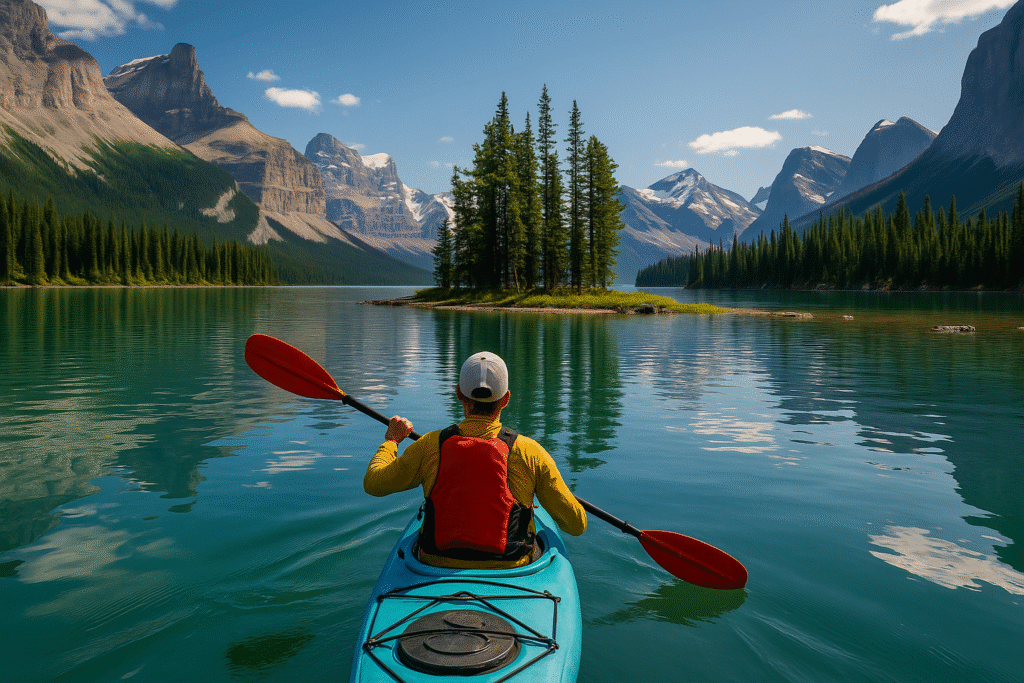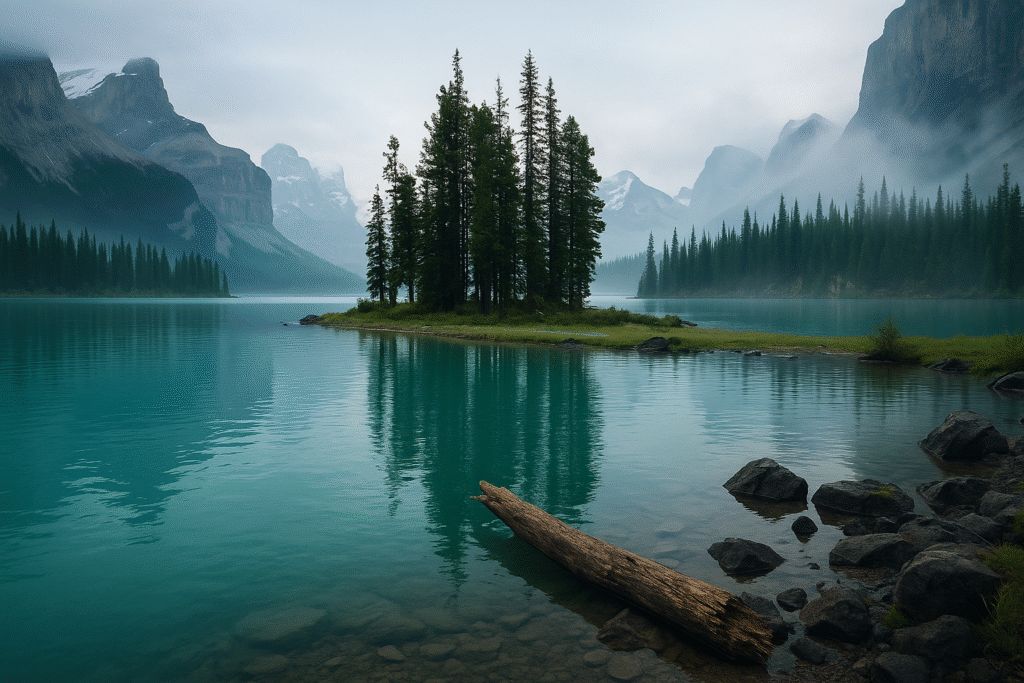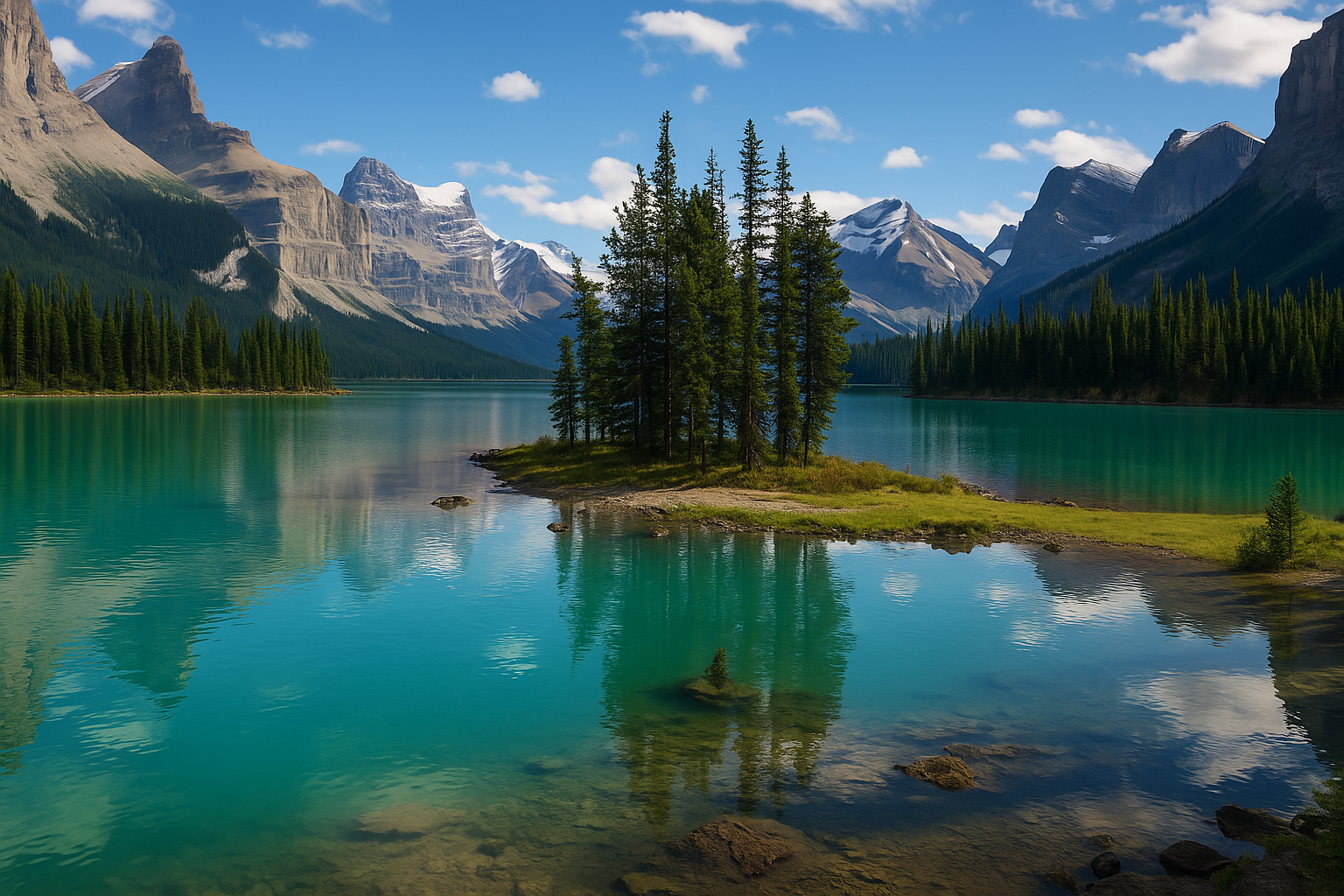Deep in the heart of the Canadian Rockies is a place so breathtaking. It is so mysterious that even reaching it feels like entering another world.
This is Spirit Island. It is a tiny patch of land floating in the turquoise waters of Maligne Lake. The island is surrounded by the towering peaks of Jasper National Park, Alberta.
It’s one of Canada’s most photographed landmarks. Yet, few realize that this small island is sacred. It is completely off-limits to the public.
🌫️ A Journey Through the Mist
I had been kayaking across Maligne Lake for hours when the weather turned. What was once a clear blue sky quickly vanished into a heavy, haunting fog.
For a moment, the world disappeared. There was no horizon. I heard no sound but the soft splash of my paddle. A distant groan of a glacier shifted high above.

The stillness was so complete it felt unreal. Then, out of the mist, the dark outlines of pines began – faint, fleeting, ghostlier.
That’s when I knew I was close.
Spirit Island reveals itself like a vision. One moment it’s invisible; the next, it’s right there — calm, perfect, untouchable.
🌄 A Jewel of the Rockies
Set against the snowcapped mountains of the Hall of the Gods, Spirit Island looks like something out of a painting.
It isn’t technically an island for most of the year. A narrow strip of land connects it to the shore when the water level drops. Its beauty is unmatched.
The world first discovered it in 1960. This happened when a giant photograph of the island was displayed in New York City’s Grand Central Station. From that moment, the image of those evergreens framed by glaciers became one of Canada’s most iconic scenes.
Decades later, Spirit Island has been featured by Apple. Travel magazines also highlight it, and filmmakers have celebrated it too. It has become a global symbol of natural perfection.
“It’s one of the most awe-inspiring places in the world,” says Tyler Riopel, CEO of Tourism Jasper. “But when you’re there, you realize it’s much more than just a pretty picture.”
🚣 The Journey to Spirit Island
Reaching the island is no easy task. There are no roads or trails that lead to it – only water.
Visitors can either take a guided boat cruise or paddle their own way across the 28-kilometre round-trip route. The cruise offers a brief stop for photos, but kayaking through the calm, glacial-blue waters is another experience entirely.
The lake changes color as you move deeper. It shifts from soft blue to vivid turquoise. This is a natural effect caused by glacial “rock flour” reflecting the sunlight.
The closer you get, the quieter everything becomes. Mountains close in, and the air turns cold and pure. Then suddenly, you see it – Spirit Island, untouched and serene.
🪶 Sacred Ground
Despite its fame, almost no one is allowed to step foot on the island. The land is considered sacred by the Stoney Nakoda Nation, who have long known it as Githni-mi-Makoche, or Healing Island.
“For thousands of years, our ancestors came here for healing ceremonies,” explains Barry Wesley, a Stoney knowledge keeper.
“These mountains are part of our spirit. They represent our ancestors, and this island is where the land and water connect – where healing begins.”
When Jasper National Park was created in 1907, Indigenous communities were forcibly removed from their ancestral lands, including this one. Only in recent years have the Stoney people been able to return to conduct traditional ceremonies again.
Wesley describes visiting Spirit Island as listening to the land’s heartbeat. “When you go there,” he says, “you feel its energy. If you creep and leave no trace, it will tell you its story.”
🔥 Reclaiming History
Spirit Island’s story is also one of rediscovery – and reconnection.
Over a century ago, Mary Schäffer Warren was an explorer and photographer from Pennsylvania. She came searching for a legendary “glowing lake.”
After weeks of failure, a Stoney hunter named Samson Beaver drew her a simple map. Schäffer Warren followed his directions. She became the first non-Indigenous person to see Maligne Lake. She called it “the finest view any of us had ever beheld.”
Her book Old Indian Trails of the Canadian Rockies introduced the world to the area. It also inspired the creation of Jasper National Park. But the Indigenous families who helped her – including Beaver’s – were later displaced.

Today, their descendants, including Wesley, are reclaiming both the land and their stories. Every summer, the Stoney return to Spirit Island to perform healing rituals – a quiet act of remembrance and renewal.
The Fragile Beauty of Jasper
The journey to Spirit Island also reveals the changing face of the Rockies.
Glaciers that once towered hundreds of meters high have retreated dramatically, leaving behind barren rock.
Tim Patterson, an Indigenous guide with Zuc’min Guiding, calls them “tombstones of ice.”
“The land is changing faster than ever,” he says. “But through Indigenous stewardship, we can learn how to protect what remains.”
Other Indigenous guides across Alberta are helping visitors reconnect with the Rockies’ true story. They present it not just as a scenic wonder, but as a living, sacred landscape.
✨ The Island That Watches in Silence
When I finally reached Spirit Island, I kept my distance.
A small wooden sign at the water’s edge read:
“Spiritual and fragile area. No access.”
I drifted close enough to see a slender staff planted upright among the trees. The Stoney left it as a symbol after each ceremony. This honors the land.
For a long time, I just sat there, letting the silence settle. Mist curled between the peaks; the water shimmered turquoise and gold under the rising sun.
It felt like time had stopped.
Spirit Island is not a place you conquer or even visit – it’s a place you witness.
For those who are fortunate to see it, even from afar, it leaves an unforgettable impression.






Leave a Reply